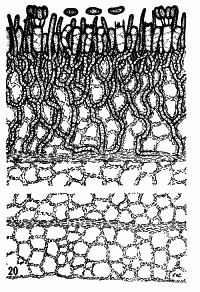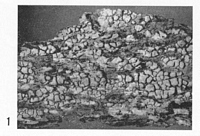|
 Corticium kauri Corticium kauri
BiostatusPresent in region - Indigenous. Endemic
Images (click to enlarge)
Caption: TEXT-FIG. 20. Corticium kauri. x 500. | 
Caption: PLATE 13, FIG. 1. Corticium kauri. x 1. |
Article: Cunningham, G.H. (1954). Thelephoraceae of New Zealand. Part III: the genus Corticium. Transactions of the Royal Society of New Zealand 82(2): 271-327.
Description: Hymenophore perennial, stratose, adnate, membranous-coriaceous, at first effused, forming
small areas to 6 x 2 cm., becoming deeply areolately angularly fissured when each segment
becomes separated, each appearing as a separate colony irregular in shape and 2-10 mm. long;
surface white, becoming pallid cream, deeply creviced; margin at first thin, white, crustose,
becoming thick and cliff-like. Context white, 0.7-2 mm. thick, arranged in 20-30 vague layers
delimited by tinted zones of collapsed parallel hyphae, fertile layer of mainly vertical hyphae
widely spaced with collapsed partly pseudoparenchymatous hyphae between; other layers of
collapsed hyphae arranged into a coarsely cellular pseudoparenchyma; generative hyphae 2.5-3 µ diameter, wall 0.25 µ thick, naked, hyaline,
branched, septate, with clamp connections.
Hymenial layer to 35 µ deep, of basidia, paraphyses and paraphysate hyphae. Basidia
subclavate, 12-18 x 6-8 µ, 4-spored; sterigmata slender, to 6 µ long. Paraphyses scanty,
subclavate, about half the size of the basidia. Paraphysate hyphae filiform, projecting, with
rounded or acuminate apices. Spores elliptical or suballantoid, 7-9 x 4-4.5 µ, wall smooth,
hyaline, 0.2 µ thick.
Habitat: HABITAT. Adnate on much decayed decorticated wood.
Distribution: DISTRIBUTION. New Zealand.
Notes: Readily recognised by the numerous small, tuberculate, white colonies crowded on rotten
decorticated wood. They arise from fructifications which at first are plane and continuous.
Soon these become deeply fissured, each segment continuing to develop as a separate entity,
the plant being perennial, edges becoming rounded somewhat, though still retaining their
vertical faces. Sections show thick specimens to consist of 20-30 rather vague layers, all save
the fertile layer being composed of collapsed gelatinized hyphae arranged into a coarsely
cellular pseudoparenchyma, separated by bands of parallel gelatinized collapsed hyphae tinted
brown. The species appears to be confined to the one host, Agathis australis, the Maori name
for which is kauri, hence the specific epithet.
Article: Stalpers, J.A. (1985). Type studies of the species of Corticium described by G.H. Cunningham. New Zealand Journal of Botany 23(2): 301-310 (http://www.rsnz.org/publish/abstracts.php).
Notes: The type specimen shows collapsed hyphae, no hymenial structures and non-amyloid
basidiospores as described by Cunningham. More material is needed before a more definite
statement on its taxonomic position can be made. The species causes a brown rot.
|